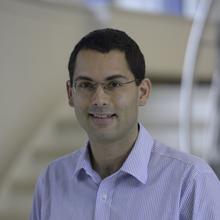Transforming calculations for chemists
Innovative software invented by senior lecturer Dr Chris Skylaris could hold the key to major breakthroughs in the discovery of new drugs, energy sources or agents to tackle pollution.
Since 1996 he has been developing new computational methods that enable chemists to simulate complex, lengthy and expensive molecular experiments at an atomic level. He has led the development of the ONETEP program which is already used extensively by academics worldwide and marketed to industries through Accelrys. Chris continues to work to improve its systems and processes.
“Scientists need to have a way of predicting what molecules will do in reactions before testing them in the laboratory, to find out if they could be used for drugs or other purposes. They can then weed out unsuccessful candidates at an early stage,” explains Chris.
The principles for a theory needed to simulate molecular reactions were established in the 1920s, following work by Nobel laureate Erwin Schrödinger. When computers were invented, these paper-based theories became programs. However, the new science of quantum chemistry became more relevant with the arrival of supercomputers which can carry out trillions of calculations every second.
His innovation was to discover a workable way of extending the calculations to much larger molecules than possible before, allowing simulations even on molecules that are encountered in biology and nanoscience.. Calculating the potential results when molecules react at an atomic level is an enormous task requiring much computing power, Chris’s system achieves satisfactory results using IT facilities available at most universities.
Chris took his first degree in Chemistry at the University of Athens, studied for a PhD at the University of Cambridge and undertook postdoctoral work there. He was awarded a Royal Society University Research Fellowship at the Physical and Theoretical Chemistry Laboratory of the University of Oxford in 2004 and joined Southampton in 2006.
